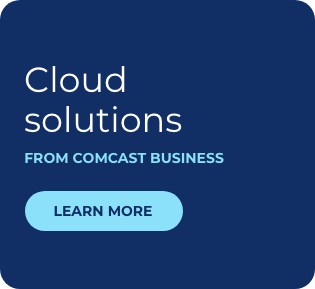Four Considerations for Networking Your Hybrid Cloud Environment
.png?sfvrsn=153a79fa_1)
Taking the Complexity Out of Connecting to the Cloud
Thursday, June 28, 2018 1:00 PM - 2:00 PM EDT
Register
Currently 81 percent of enterprises have a multi-cloud strategy, and more than half (51 percent) have a hybrid cloud strategy, according to the RightScale 2018 State of the Cloud Report. That means most companies are dealing with how to optimize multi-cloud environments or environments that combine on-premises workloads with those in public and private clouds.
The ultimate goal is to create a seamless infrastructure in which automated workloads and data interact and move between multiple clouds and on-premises resources without noticeable performance degradation or compatibility issues. Only then can an environment truly be considered hybrid.
Hybrid environments deliver plentiful benefits. They make it possible to host workloads closer to users, thus improving response times. Hosting each component of a workload in the environment best suited for it ensures better performance and cost.
For example placing a web front end in the cloud allows customers to access a resource – let’s say an eCommerce site or service portal – anywhere, anytime and with any device. Depending on the setup, the front end may be accessing data hosted securely in an in-house database or private cloud.
Infrastructure may need to be specialized to meet specific workload requirements. For example, an application or data might need to be hosted in a specific location or have security concerns that need to be addressed. Workloads sometimes have special hardware requirements that can’t be procured from a public cloud provider or the hosted options that are available, may not be cost-effective – i.e., you have to buy more compute power than you need because what you need is not available. Other parts of the end-to-end application might still run in a public cloud to improve performance.
Achieving nirvana with a hybrid cloud environment requires meticulous planning and execution, but it is possible. For optimal results, organizations moving to a hybrid cloud environment must address these four areas of concern:
- Understand their current infrastructure needs
- Determine what to do with legacy systems
- Define the role of new connectivity approaches
- Consider how to secure the entire environment
Needs Assessment
Many projects fail because the foundations are weak; planners overlook fundamentals such as network design and neglect to forecast bandwidth requirements for each application that is either moved to the cloud or introduced anew. You need to tackle questions such as how will applications interact with each other, how much data will be flowing between applications and infrastructures and how many users will be accessing the applications.
To determine what to move to the cloud, organizations must assess their infrastructure needs. Architects must take into consideration that different IT workloads place different demands on infrastructure, including the network. While some are ideal for public cloud environments, others are best handled in hosted private clouds or kept in-house due to considerations of control, security and regulations. There’s a lot to take into consideration, including resource-hogging workloads, cloud connections, anytime/anywhere access and security requirements.
Consider also any limitations that moving to the cloud may impose. On the one hand, new cloud automation and intelligent tools help run the infrastructure. On the other hand, you surrender control of how your applications communicate with each other once they’re in the cloud. Depending on the cloud setup, you may have fewer options in these areas and be dependent on whatever is available from the cloud provider.
Legacy Systems
Legacy systems (outdated computer systems, programming languages or application software), are inherently complex to run, making them costly to maintain and often requiring specialized skills that are in short supply. They often suffer from vulnerabilities and are difficult to integrate with newer systems. Many new applications are not readily available on legacy systems.
These obstacles are often the reason businesses look to move legacy workloads to newer systems in the cloud. But not all workloads belong in the cloud. Although legacy infrastructure is not ideal for high resource consumption, distributed workloads, or quick low-touch deployment, the older technologies can still handle a lot of mission-critical applications. Such workloads may not always benefit from migration to a cloud infrastructure because they are delivering the right performance, don’t need to “talk” to every other workload, or simply won’t run there.
Networking Options
Legacy networks (older network infrastructure) also may struggle to keep up. Cloud deployments can frequently place a heavier burden on networks, which may overwhelm legacy network infrastructure. Latency and performance issues can ensue, frustrating users and preventing businesses from fully enjoying the benefits of the cloud. Ultimately, these issues affect an organization’s competitiveness and its ability to serve customers in a timely and efficient manner.
When moving workloads to the cloud, teams not only need to understand workload and network requirements but also current network capabilities and capacities. Sometimes poor end user experience is not due to the applications or systems, but rather due to inadequate network capabilities or performance. Direct connections to a cloud resource may resolve performance bottlenecks.
Legacy infrastructures are inflexible and counterproductive to cloud consumption models. A software-defined network (SDN) infrastructure governed by policy and business goals makes it possible to guide traffic based on application location without unnecessary extra hops. Administrators, meanwhile, gain the flexibility to allocate resources and control as needed without encumbrances based on location or the types of device in use.
If legacy network environments are not up to the job, consider augmenting or replacing them. As private, direct connections and software-defined network (SDN) options gain traction, organizations should acquaint themselves with the benefits of these alternatives and how they can support their hybrid cloud strategies.
Protecting your Data
When developing a hybrid cloud strategy, it’s important to consider how you will secure the data hosted in and traveling between multiple clouds and on-premises resources. Effective security management requires a number of functions, such as encryption, monitoring, scanning, filtering, quarantining and mitigation. Administrators also have to set rules to control user access and connections between different resources.
Enterprises need secure connectivity to protect data in motion as it travels between cloud infrastructures and on-premises resources. Secure connectivity is also essential to safely recover data from cloud-based backups when the need arises. All critical data should be replicated in a secure cloud location so it is readily available should a cyber-attack or some other type of downtime-causing incident occur.
Security should be in the forefront of any plan to adopt a hybrid cloud environment model. Treat it as an afterthought, and you’re bound to pay the price later.
Laying the Groundwork
Hybrid environments allow organizations to leverage emerging technologies and deploy new business applications that support strategic goals and enhance the customer experience. But you can’t just flip a switch to activate a hybrid environment. By properly addressing considerations such as the role of legacy environments, infrastructure needs, security and business continuity, and the impacts of newer networking technologies, you can lay the groundwork for a computing platform that increases operational efficiencies, helps accelerate go-to-market strategies and enhances the customer experience.
Hybrid environments allow organizations to leverage emerging technologies and deploy new business applications.
Locked Content
Click on the button below to get access
Unlock NowOr sign in to access all content on Comcast Business Community
Learn how Comcast Business can help
keep you ready for what's next.











